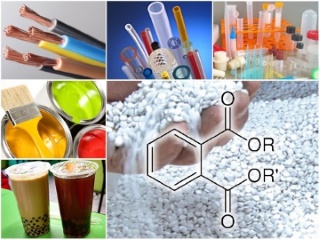Studying The Plasticizer - Phthalates

Phthalate Acid Esters (hereafter refers as PAEs, or Phthalates), a kind of chemical substances are well known in the public media in recent years. Due to PAEs exist widely in our environment, and proved the linkage of cancer and infertility by the scientific researches, PAEs became the substances which are dreaded and shunned in the public.
Phthalates are often used to produce various products, such as the packaging material for food and beverage, medical equipment, construction materials, protective coating varnish for woods, flexible tubes, insulation of electric wires and cables, lubricants, perfumes, hair sprays, cosmetics, and so on. Phthalates are primarily used as an additive inside plastics. It helps a plastic, such as polyvinyl chloride (PVC), become flexible and elastic, so that PAEs is commonly called "plasticizer".
There six common types of phthalates, its toxicological and pathological characteristics are collected in the following table.
Table 1. Six common plasticizers and their toxicity
|
DEHP |
Di(2-ethylhexyl) phthalate |
In animal studies, DEHP can cause reproductive and developmental harms to animals. These results insinuate the same harms to humans. Especially male, children, pregnant, and lactating women. |
|
DIDP |
Diisodecyl phthalate |
Generally, children reach more DIDP than adults, mainly from the toys |
|
DINP |
Diisononyl phthalate |
Children exposure tens or even hundred times then adults, via contacting or chewing the toys. In toxicological studies, DINP has weaker toxicity than DIDP. |
|
DNOP |
Di(n-octyl) phthalate |
There are no obvious toxicological study results. |
|
BBP |
Butyl benzyl phthalate |
The results proved the reproductive toxicity to mice, and developmental toxicity to rats. It is considered to have the same toxic to humans. |
|
DBP |
Di-n-butyl phthalate |
Study reported that the developmental toxicity to mice and rats, which exposure to DBP. |
Among the six kinds of plasticizers, DEHP is paid attention by scientists, because of its toxicity, which is highly related to infertility and cancer.
The global demands of DEHP is about 1/4 of the entire plasticizations. Most of the DEHP are used in PVC plastic production, which is produced from vinyl chloride. DEHP is typically mixed with other plasticizers, heat stabilizers (such as lead, cadmium, zinc, and tin), and lubricants, in order to change the characteristics of plastics in both mechanical and physical behaviors. Some of the vinyl chloride even contains more than 40% of DEHP. Due to the fact of its impact to human endocrine even contain more than 40% of vinyl chloride of DEHP. Due to the fact of its influences to human endocrine, it has been paid attention by governments of each country.
Nowadays, there are around 60 million tons of PVC plastic are produced a year, due to its complex and divers chemical characteristics, resulting in difficulties in classification and recycling, only a very small percentage (<0.5%) of PVC products are recycled. This shows most of PVC plastics are separated into the environment, either in landfills or in incineration plants. Those ones in landfills often penetrate into the groundwater, and the rest in incineration are burned and produced various highly toxic chemicals, which were released into the air. Such as polychlorinated dibenzodioxins (PCDD) and polychlorinated dibenzofurans (PCDF), are harmful to human’s health under certain extent.
So, every year, a huge quantity of PVC plastic consumer products and industrial products were manufactured. One can imagine that PVC plastics are almost everywhere, long-term presence in the environment where we’re living. That’s why we are exposed in the DEHP threat all the time. DEHP can be found in body fluids, such as blood, semen, breast milk, saliva, and amniotic fluid. Therefore, since year 2011, after the storm of plasticizers which were found in the foods, Taiwan government announced the selling activities are forbidden, if the related foods didn’t pass the self-test since June 2011.
The modern instrument technologies which are used to detect the plasticization includes, Gas Chromatograph (GC), High Performance Liquid Chromatograph (HPLC), Infrared Spectrometer (IR), Ultraviolet Spectrophotometer (UV), Nuclear Magnetic Resonance (NMR), Inductively Coupled Plasma Reactive Ion Etching (ICP), Atomic Absorption Spectrometer (AAS), X-ray Diffraction Analyzer (XRD), Thermogravimetric Analyzer (TGA), Sample Preparation, where GC and HPLC are usually chained with a Mass Spectrometer (MS).
ACTTR Technology concerns about the potential health problems of Taiwan citizens, and highly dedicates in the related plasticization inspection instrumentation technologies. We keep contacting to the worldwide instrument and equipment suppliers, and discussed with them for a better cost-effective ways for plasticization inspections, in order to participate the contributions for the food & beverage safety in Taiwan.


